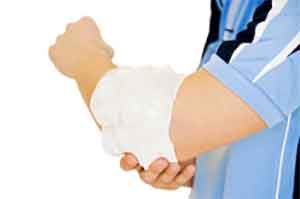What constitutes good treatment of tennis elbow?
What is the best treatment for acute tennis elbow? Physiotherapy? Cortisone? A combination? Or might you just as well forego treatment?
 The two most common treatments for tennis elbow are physiotherapy and cortisone injections. It is unclear which of these gives the best result, and diagnosis can be problematic for general practitioners. Now researchers at teh University of Oslo have taken a closer look at the treatment methods.
The two most common treatments for tennis elbow are physiotherapy and cortisone injections. It is unclear which of these gives the best result, and diagnosis can be problematic for general practitioners. Now researchers at teh University of Oslo have taken a closer look at the treatment methods.
Two-part study of tennis elbow
Tennis elbow usually improves without treatment, but some people may have symptoms for up to two years.
“Tennis elbow can be very distressing. Patients have to suffer persistent and often severe pain. They have reduced function in the elbow and many have to go on sick leave,” says Morten Olaussen.
Together with Øystein Holmedal, Olaussen has headed a combined literature review and clinical study.
They began by undertaking an in-depth study of the literature, and a thorough review of published studies showed the effectiveness of some types of physiotherapy. Cortisone injections should be used with caution, as many patients experience a relapse, and the long-term effects are uncertain.
The treatment study
The main part of the research project was a clinical study. The researchers wished to ascertain how acute tennis elbow developed without special treatment, with physiotherapy alone, and when the patient receives physiotherapy accompanied by cortisone injections. The investigation was designed as a randomized, placebo-controlled study. The patients were monitored for one year and divided into three groups:
The patients received two cortisone injections plus physiotherapy
The patients received placebo injections as well as physiotherapy
The patients in the control group did not receive any treatment
Many people recover without treatment
The study revealed that acute tennis elbow is a condition from which two-thirds of patients recover in the course of one year irrespective of whether or not they receive treatment. For the final third of patients, who still had symptoms after one year, there was a significant need for further treatment and sick leave. The effect of physiotherapy alone was no better than watchful waiting (no treatment).
“It came as a surprise that physiotherapy, especially eccentric exercise, did not help,” says Olaussen.
“This type of exercise has otherwise proved to be effective for chronic symptoms. Perhaps the acute condition that we have studied is an infection that later develops into a chronic condition, with changes in the tissue and tendon? Or possibly the combination of the different types of physiotherapy that we used was detrimental,” he suggests.
Physiotherapy together with cortisone injections resulted in significant short-term improvement, but many people then experienced a temporary exacerbation of symptoms.
At the one-year follow-up, the results were the same for all three groups. There was therefore no indication that those who had received cortisone injections as well as physiotherapy had a poorer outcome after one year.
“The main conclusion was that two-thirds of patients with acute tennis elbow recover after one year without any special treatment,” says Olaussen.
“In our study, physiotherapy had little effect. If you need a quick recovery, cortisone injections together with physiotherapy may be appropriate. Many people will then experience a quick recovery, but symptoms will temporarily worsen after a while. This means that we cannot recommend this treatment to everyone, even though it has no long-term detrimental effect,” concludes Olaussen.
Research in general practice
The project has been conducted in general practice in Sarpsborg, where all of the local GPs have referred patients for the study.
“This was an exciting, patient-centred project. For conditions that are treated in general practice, it is important that research is conducted within the same setting and with the same patient population,” Olaussen concludes.
Source: University of Oslo, Faculty of Medicine
Full bibliographic information:
Morten Olaussen, Øystein Holmedal, Ibrahimu Mdala, Søren Brage and Morten Lindbæk: Corticosteroid or placebo injection combined with deep transverse friction massage, Mills manipulation, stretching and eccentric exercise for acute lateral epicondylitis: a randomised, controlled trial
BMC Musculoskeletal Disorders 2015, 16:122

